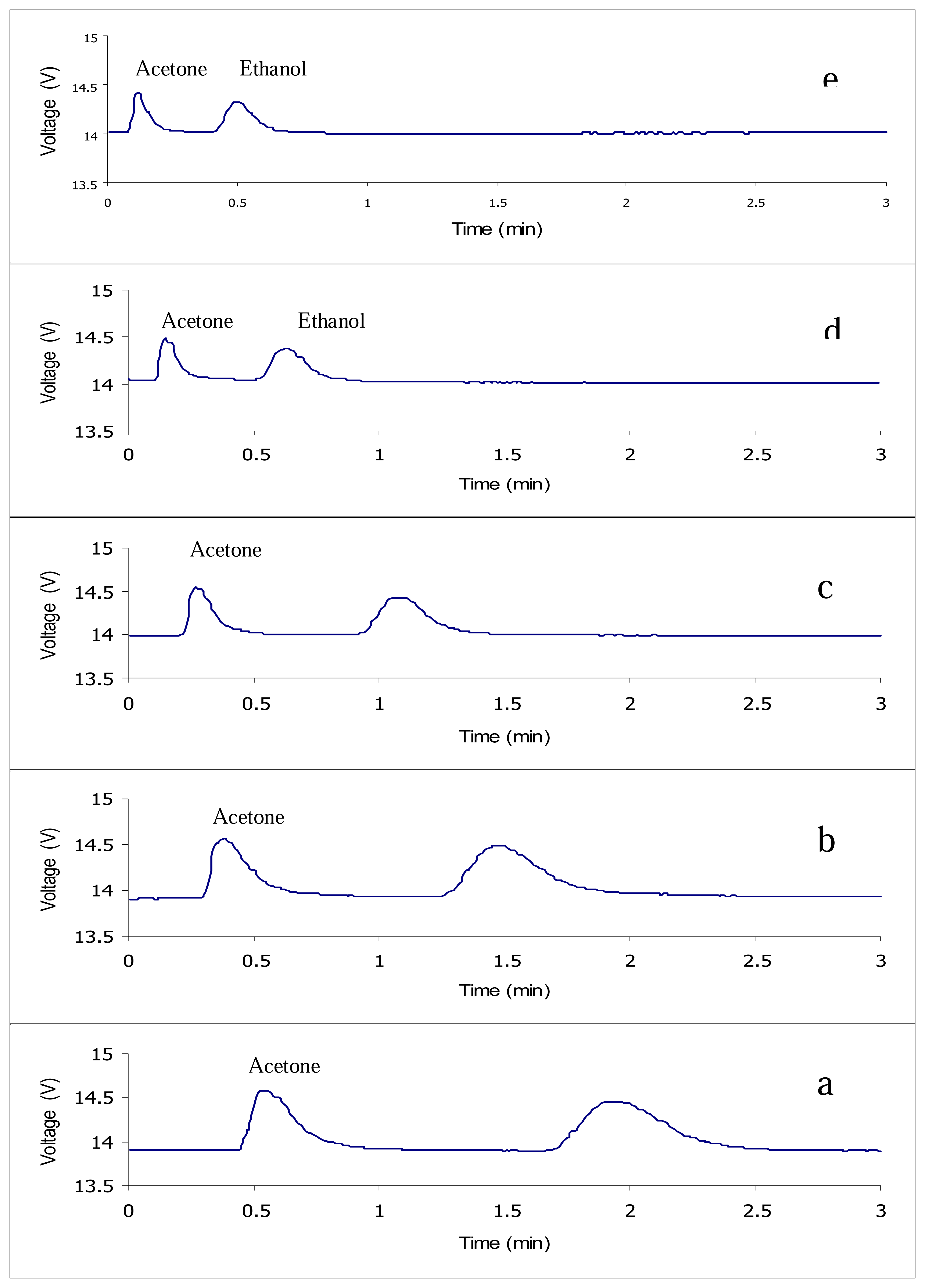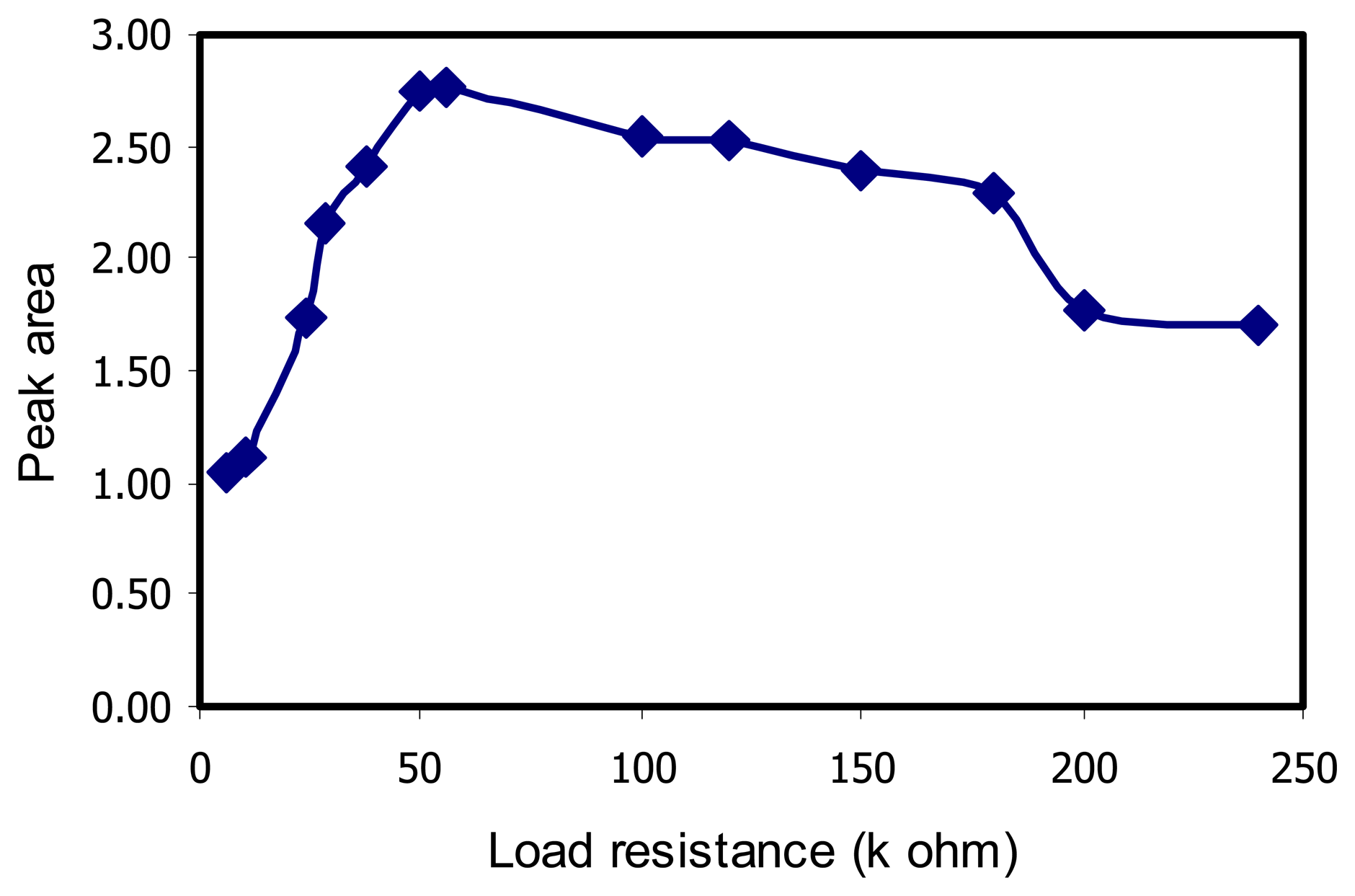Home-made Detection Device for a Mixture of Ethanol and Acetone
Abstract
:1. Introduction
2. Preparation of the stock standard solution
2.1 Ethanol stock solution (1000 mg/L)
2.2 Stock standard solution of acetone (1000 mg/L)
2.3 Preparation of the standard ethanol and acetone concentration of 10.00, 20.00, 40.00, 80.00 and 160.00 mg/L
3. Construction of the detection device
- (i)
- The carrier gas flow rate was 15 mL/min.
- (ii)
- Circuit conditions were VH = 5.5 V, VC = 20 V and RL = 68 kΩ.
- (iii)
- The temperature of the injection port was 150 °C.
3.1 Characteristics of the procedure
3.1.1 Linearity range
3.1.2 Limit of detection (LOD)
4. Results and discussion
4.1 Optimization of the sensor system
4.1.1 Effect of flow rate of carrier gas
4.1.2 Optimization of the heating coil VH



4.1.3 Optimization of VC of the circuit sensor
4.1.4 Optimization of RL of the circuit sensor
| where | RS is the resistance of sensor |
| VC is the voltage of the circuit sensor | |
| RL is the load resistance of the circuit sensor | |
| VRL is the output voltage in the resistance |
4.1.5 Optimization of the injection port temperature
4.2 Characteristics of the procedure
4.2.1 Linearity range
4.2.2 Limit of detection (LOD)
5. Conclusions
Acknowledgments
Referentes
- Capone, S.; Forleo, A.; Francioso, L.; Rella, R.; Siciliano, P.; Spadavecchia, J.; Presicce, D. S.; Taurino, A. M. Solid State Gas Sensors: State of the Art and Future Activities. J. Electron. Mater. 2003, 5, 1335–1348. [Google Scholar]
- Jie, Z.; Huo, L.-H.; Gao, S.; Zhao, H.; Zhao, J.-G. Alcohols and acetone sensing properties of SnO2 thin films deposited by dip-coating. Sens. Actuators B: Chem. 2006, 115, 460–466. [Google Scholar]
- Tianshu, Z.; Hing, P.; Li, Y.; Jiancheng, Z. Selective detection of ethanol vapor and hydrogen using Cd-doped SnO2-based sensors. Sens. Actuators B: Chem. 1999, 60, 208–215. [Google Scholar]
- Mandayo, G. G.; Castano, E.; Gracia, F. J.; Cirera, A.; Cornet, A.; Morante, J. R. Strategies to enhance the carbon monoxide sensitivity of tin oxide thin films. Sens. Actuators B: Chem. 2003, 95, 90–96. [Google Scholar]
- Tan, O. K.; Cao, W.; Zhu, W.; Chai, J. W.; Pan, J. S. Ethanol sensors based on nano-sized α-Fe2O3 with SnO2, ZrO2, TiO2 solid solutions. Sens. Actuators B: Chem. 2003, 93, 396–401. [Google Scholar]
- Yoon, J. W.; Grilli, M. L.; Bartolomeo, E. D.; Polini, R.; Traversa, E. The NO2 response of solid electrolyte sensors made using nano-sized LaFeO3 electrodes. Sens. Actuators B: Chem. 2001, 76, 483–488. [Google Scholar]
- Korotcenkov, G.; Brinzari, V.; Cerneavschi, A.; Ivanov, M.; Cornet, A.; Morante, J.; Cabot, A.; Arbiol, J. In2O3 films deposited by spray pyrolysis: gas response to reducing (CO, H2) gases. Sens. Actuators B: Chem. 2004, 98, 122–129. [Google Scholar]
- Korotcenkov, G.; Brinzari, V.; Cerneavschi, A.; Ivanov, M.; Cornet, A.; Morante, J.; Cabot, A.; Arbiol, J. In2O3 films deposited by spray pyrolysis as a material for ozone gas sensors. Sens. Actuators B: Chem. 2004, 99, 297–303. [Google Scholar]
- Ionescu, R.; Hoel, A.; Granqvist, C. G.; Llobet, E.; Heszler, P. Low-level detection of ethanol and H2S with temperature-modulated WO3 nanoparticle gas sensors. Sens, Actuators B: Chem. 2005, 104, 132–139. [Google Scholar]
- Guérin, J.; Aguir, K.; Bendahan, M.; Lambert-Mauriat, C. L. Thermal modelling of a WO3 ozone sensor response. Sens. Actuators B: Chem. 2005, 104, 289–293. [Google Scholar]
- Blo, M.; Carotta, M. C.; Galliera, S.; Gherardi, S.; Giberti, A.; Guidi, V.; Malagù, C.; Martinelli, G.; Sacerdoti, M.; Vendemiati B.; Zanni, A. Synthesis of pure and loaded powders of WO3 for NO2 detection through thick film technology. Sens. Actuators B: Chem. 2004, 103, 213–218. [Google Scholar]
- Zhu, B. L.; Xie, C. S.; Wang, W. Y.; Huang, K. J.; Hu, J. H. Improvement in gas sensitivity of ZnO thick film to volatile organic compounds (VOCs) by adding TiO2. Mater. Lett 2004, 58, 624–629. [Google Scholar]
- Anno, Y.; Maekawa, T.; Tamaki, J.; Asano, Y.; Hayashi, K.; Miura, N.; Yamazoe, N. Zinc-oxide-based semiconductor sensors for detecting acetone and capronaldehyde in the vapour of consommk soup. Sens. Actuators B: Chem. 1995, 25, 623–627. [Google Scholar]
- Cheng, X. L.; Zhao, H.; Huo, L. H.; Gao, S.; Zhao, J. G. ZnO nanoparticulate thin film: preparation, characterization and gas-sensing property. Sens. Actuator B: Chem. 2004, 102, 248–252. [Google Scholar]
- Zhu, B. L.; Xie, C. S.; Wang, A. H.; Zeng, D. W.; Song, W. L.; Zhao, X. Z. The gas-sensing properties of thick film based on tetrapod-shaped ZnO nanopowders. Mater. Lett. 2005, 59, 1004–1007. [Google Scholar]
- Gong, H.; Wang, Y. J.; Teo, S. C.; Huang, L. Interaction between thin-film tin oxide gas sensor and five organic vapors. Sens. Actuators B: Chem. 1999, 54, 232–235. [Google Scholar]
- Varghese, O. K.; Malhotra, L. K.; Sharma, G. L. High ethanol sensitive in sol -gel derived SnO2 thin films. Sens. Actuators B: Chem. 1999, 55, 161–165. [Google Scholar]
- Lee, D.-S.; Kim, Y. T.; Huh, J.-S.; Lee, D.-D. Fabrication and characteristics of SnO2 gas sensor array for volatile organic compounds recognition. Thin Solid Films 2002, 416, 271–278. [Google Scholar]
- Wanekaya, A. K.; Uematsu, M.; Breimer, M.; Sadik, O. A. Multicomponent analysis of alcohol vapors using integrated gas chromatography with sensor arrays. Sens. Actuators B: Chem. 2005, 110, 41–48. [Google Scholar]
- TGS 822 for the detection of Organic Solvent Vapors; Figaro Company Limited: USA.
- Miller, J. C.; Miller, J. N. Statistics for Analytical Chemistry, 3rd ed.; Simon & Schuster: New York, 1993; pp. 115–118. [Google Scholar]
- Jiao, Z.; Gang, Y.; Chen, F.; Li, M.; Liu, J. The preparation of ZnGa2O4 nanocrystals by spray coprecipitaton and its gas sensitive characteristics. Sensors 2002, 2, 71–78. [Google Scholar]
- Ho, J. J.; Fang, Y. K.; Wu, K. H.; Hsieh, W. T.; Chen, C. H.; Chen, G. S.; Ju, M. S.; Lin, J.-J.; Hwang, S. B. High sensitivity ethanol gas sensor integrated with a solid-state heater and thermal isolation improvement structure for legal drink-drive limit detecting. Sens. Actuators B: Chem. 1998, 50, 227–233. [Google Scholar]









| Standard | Detection limit (mg/L) | Correlation coefficient (r2) |
|---|---|---|
| Acetone | 4.41 | 0.9938 |
| Ethanol | 9.27 | 0.9908 |
© 2007 by MDPI ( http://www.mdpi.org). Reproduction is permitted for noncommercial purposes.
Share and Cite
Reungchaiwat, A.; Wongchanapiboon, T.; Liawruangrath, S.; Phanichphant, S. Home-made Detection Device for a Mixture of Ethanol and Acetone. Sensors 2007, 7, 202-213. https://doi.org/10.3390/s7020202
Reungchaiwat A, Wongchanapiboon T, Liawruangrath S, Phanichphant S. Home-made Detection Device for a Mixture of Ethanol and Acetone. Sensors. 2007; 7(2):202-213. https://doi.org/10.3390/s7020202
Chicago/Turabian StyleReungchaiwat, Amnat, Teerapol Wongchanapiboon, Saisunee Liawruangrath, and Sukon Phanichphant. 2007. "Home-made Detection Device for a Mixture of Ethanol and Acetone" Sensors 7, no. 2: 202-213. https://doi.org/10.3390/s7020202




